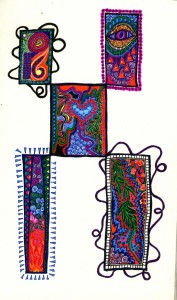 When I’m designing or coaching design of learning experiences, including “classes” or workshops – any form – I like to include a reflective activity for whomever is teaching, facilitating or leading. And I like it to be visible to all the participants. This role models reflective practice in learning and removes some of the distance (power and participation) between the teacher and the participants. I believe in some way we are all on the learning path, even though our roles may vary.
When I’m designing or coaching design of learning experiences, including “classes” or workshops – any form – I like to include a reflective activity for whomever is teaching, facilitating or leading. And I like it to be visible to all the participants. This role models reflective practice in learning and removes some of the distance (power and participation) between the teacher and the participants. I believe in some way we are all on the learning path, even though our roles may vary.
In that vein, I wanted to point out Howard Rheingold’s Teacher’s learning journal | Social Media CoLab.Howard starts his reflection with goals:
My teaching goals:
I want to create the conditions for the class as a whole to make something magical happen. I want students to take away from this course all the learning outcomes I explicitly describe, but I also want to achieve much more: I want to awaken those who have been lulled to semislumber by so many years of desks arrayed in rows and “will this be on the test?” — I want to awaken them to their own powers to use online tools and their thinking skills to not only cope, but to thrive in a world that requires continuous learning. I want to grow more aware along with my students. I want to model and facilitate exploration of and reflection about the impacts of our own media practices. I want to induce student teams to outdo each other in coming up with fun, thought-provoking, incisive, profound, ways to engage with the texts and ideas. I want to inspire so much interest in social media that students read all the required texts and even some of the recommended texts.
Why I teach this way:
The subject itself has compelled me to teach about it: I have personally explored, observed, exploited, and analyzed media since internet-based communication was in its infancy, but when social media grew from a playground and laboratory for a small group of enthusiasts into a worldwide platform for commerce, politics, sociality, I became convinced that knowing how to use and think about social media could influence the final shape of the emerging infosphere. What you know and do today matters because it will be part of setting the rules for who can use these media, how they can use them, who will profit, and who will control tomorrow’s media. When I started teaching, students were starting to use Facebook — and they were already accustomed to surfing the web during class. The same media I’ve been using and which I’m now teaching are also directly challenging traditional methods of teaching and learning. Believe it or not, the ability to find out in real time whether the professor knows what he is talking about — and to silently share what you’ve discovered with the other students in a class — is a relatively new thing. When I started asking around about how teachers and students were using social media for learning, and started asking the students themselves about what was working and what wasn’t, I began to learn that students thrive and learn from conversation among peers as well as the traditional public performance of whole-class discussion, that students’ collaborative projects amazed me and the other students with their ingenuity, that some risk-taking was exhilarating. Much of the structure of this class comes from the explicit feedback, experiment, and risk-taking of previous classes.
Given all that I’ve said so far, this description of the ideal 21st century teacher makes sense to me. I believe I fulfill some of these requirements. I strive to fulfill others. I vow to adapt, communicate, learn, envision, lead, model, collaborate, and above all, take risks. I take risks because I’ve learned that if you try something larger than your capabilities, you’ve learned something about doing something big — even if you fail. If you succeed admirably at doing something that you know you can do, you’ve learned something about doing something small. There’s nothing wrong with doing small things well. But I’m here to help those who want to go for it. This century requires thinkers who know how to take on significant challenges.
What happens, what changes when we share our intents? Does this bias participation? Seed the idea that the intent behind our actions shapes those actions? How do you as a teacher or leader show your intent?
One thought on “Reflective Teachers”
Comments are closed.